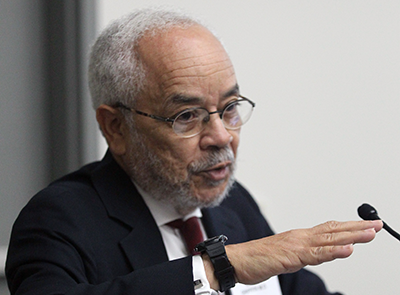Pernicious Effects of Racism Discussed in Session Honoring Chester Pierce, M.D.

The late Harvard psychiatrist Chester Pierce, M.D., left a legacy that continues to inspire his successors in the study of the connection between race and mental health in America.
“Racism is not simply a matter of personal prejudice but an organized system premised on an ideology of inferiority,” said David Williams, Ph.D., M.P.H., a professor of public health and sociology at Harvard University, during the Presidential Symposium “From Extreme Environments to Therapeutic Landscapes: Race, Psychiatry, and the Legacy of Chester Pierce.”
The effects of racism, particularly racially segregated housing, strongly influence health outcomes, said Williams. “Your ZIP code matters. Where you live determines proximity to good schools, nutritious food, safe places to walk and play, good medical care, as well as to pollution and psychosocial stressors.”
Racial hostility has even been demonstrated to increase mortality among blacks subjected to discrimination, he said. Attempts to counter racism have generally tested psychosocial interventions to counter stereotypes and increase opportunities for interracial contact. However, because racism is so pervasive throughout American society, programs that address its systemic nature must simultaneously tackle numerous factors including housing, education, jobs, and the health care system.
A toxic combination of urban renewal, deindustrialization, planned shrinkage, gentrification, and a loss of resources, accompanied by successive waves of violence, availability of illegal drugs, and HIV infection, not only devastated American cities but never allowed their citizens to recover, said Mindy Fullilove, M.D., a professor at the Parsons School in New York. A study of the Hill District, a black community in Pittsburgh, found that the shared public life and social cohesion evident from 1930 to 1960 began to break down over subsequent decades.
“Urban renewal and other city, state, and federal policies tore the neighborhood apart,” said Fullilove. Ultimately, this left a level of trauma “inconceivable outside of wartime.”
Yet Fullilove is not without hope. In her hometown of Orange, N.J., she is working to expand education for citizens at every stage of life and build on the memory of Thomas Edison’s nearby invention factory.
"The past and present are the raw material for revisioning the future,” she said.
Race asserted itself in the different ways that Americans perceived and used opioids, said Helena Hansen, M.D., Ph.D., an assistant professor of anthropology and psychiatry at New York University. Illegal drugs like heroin were connected to the black and poor, while legal, prescription opioids were available for whites, she said. Promotion of pain as the “fifth vital sign” and heavy commercial marketing of Oxycontin in the 1990s led to the takeoff of those prescription medications as drugs of abuse.
Ironically, the treatments for opioid use disorder were also divided. Methadone is handed out to a stigmatized population under tightly controlled conditions at clinics set in marginalized neighborhoods. High-priced buprenorphine, however, was marketed for a “new kind of addict” (that is, white and insured) and is dispensed in private doctors’ offices.
Overdose rates in France—a country with a national health system, Hansen noted—dropped 80 percent in the first four years of use, while the number of overdoses in the United States have quadrupled in the first 10 years after approval.
“The public health potential of buprenorphine is limited by our racially segregated and commercially driven health care system,” she said. “We have a clinical track for whites and a criminal track for the rest.”
In summing up the session, Ezra Griffith, M.D. (pictured above), a professor of psychiatry at Yale University, noted that Pierce played an important role in the evolution of black participation in APA.
“At the 1969 APA meeting, Pierce and Al Cannon, M.D., made it clear that APA was ignoring the needs of it black members,” said Griffith. “At the time, blacks lacked a sense of belonging to APA.”
Yet Pierce always encouraged Griffith and others to join and remain in APA because “professional organizations could be landscapes where individuals can structure communities for purpose, direction, and continuity,” said Griffith.
That APA has just completed a year with its first Latina president (Maria A. Oquendo, M.D., Ph.D.) and elected its first black president-elect (Altha Stewart, M.D.) marked another milestone in the history of the organization, he said.
(Image: David Hathcox)
|
|
|
|
|


